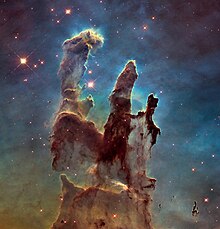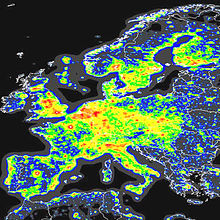Visible astronomy
Visible light astronomy encompasses a wide variety of observations through telescopes that are sensitive in the visible light range (optical telescopes). Visible-light astronomy is part of optical astronomy and differs from astronomies based on invisible types of light in the electromagnetic radiation spectrum, such as radio waves, infrared waves, ultraviolet waves, X-ray waves, and gamma ray waves. Visible light has a wavelength of 380 to 750 nanometers.
Visible-light astronomy has been around for as long as people have been looking up at the night sky, though it has since improved their ability to observe since the invention of the telescope, which is commonly attributed to Hans Lippershey, a German-born entertainer. Dutch, although Galileo played a large role in the development and creation of telescopes. Visible-light astronomy continues to improve today, with projects like the James Webb Telescope scheduled to launch in the next few years.
Since visible light astronomy is restricted to visible light only, no equipment is needed for simple stargazing. This means that it is the most commonly engaged type of astronomy, as well as the oldest.
History
Beginnings
Before the advent of telescopes, astronomy was limited to unaided vision. Humans have observed the stars and other objects in the night sky for thousands of years, as is evident in the naming of many constellations, particularly the mostly Greek names used today.
Hans Lippershey, a German-Dutch entertainer, is commonly credited with being the first to invent the optical telescope. Lippershey is the first person on record to apply for a patent for a telescope; however, it is not clear whether Lippershey was the first to build a telescope. Relying only on uncertain descriptions of the telescope for which Lippershey attempted to obtain a patent, Galileo Galilei built a telescope with approximately 3× magnification in the following year. Later Galileo made improved versions with up to 30× magnification. With a Galileo telescope, the observer could see magnified and vertical images on Earth; it was what is commonly known as a spotting scope or spyglass. Galileo would also use it to observe the sky, and for a time he was one of those who could build telescopes good enough for the purpose. On August 25, 1609, Galileo showed Venetian legislators one of his first telescopes, with a magnification of up to 8 or 9. Galileo's telescopes were also a profitable sideline, selling them to merchants who found them useful both in the sea to use them as merchandise. He published his first telescopic astronomical observations in March 1610 in a short treatise entitled Sidereus Nuncius (Starry Messenger).
Today
Visible-light astronomy is still practiced by many amateur astronomers today, especially since telescopes are much more widely available to the public than when they were first invented. Government agencies, such as NASA, are heavily involved in the research and observation of visible objects and celestial bodies. Currently, the highest quality images and data are obtained through space telescopes; telescopes that are outside the Earth's atmosphere. This allows much clearer observations to be made, as the atmosphere does not disturb the quality of the telescope's image and vision, which means that objects can be observed in much greater detail, and objects much more distant or with little light can be observed. light. Furthermore, this means that observations can be made at any time, rather than just overnight.
Hubble Space Telescope
Main article: Hubble Space Telescope
The Hubble Space Telescope is a space telescope created by NASA, and was launched into low Earth orbit in 1990. It is still in operation today. The Hubble Space Telescope's four main instruments observe in the near-ultraviolet, visible, and near-infrared spectra. The Hubble images are some of the most detailed images ever taken, which has led to many advances in astrophysics, such as the precise determination of the expansion rate of the universe.
James Webb Space Telescope
Main article: James Webb Space Telescope
The James Webb Space Telescope is the formal successor to the Hubble Space Telescope. Scheduled for launch on March 30, 2021, it is "one of the most ambitious and technically complex missions in which the NASA has turned its attention" The James Webb Space Telescope is a space telescope, and is scheduled to orbit near the second Lagrange point of the Earth-Sun system, 1,500,000 km from Earth.
Optical telescopes
Main article: Optical telescope
There are three main types of telescopes used in visible-light astronomy:
- Refraction telescopes, which use lenses to form the image. Commonly used by amateur astronomers, especially to see brighter objects such as the Moon, and planets, due to their lower cost and ease of use.
- Reflection telescopes, which use mirrors to form the image. Commonly used for scientific purposes.
- Catalan telescopes, which use a combination of lenses and mirrors to form the image; essentially a combination of refractor and reflective telescopes.
Each type of telescope suffers from different types of aberration; Refracting telescopes have chromatic aberration, which causes colors to show up at the edges that separate the light and dark parts of the image, where there shouldn't be such colors. This is because the lens cannot focus all colors to the same point of convergence. Reflecting telescopes suffer from various types of optical inaccuracies, such as off-axis aberrations near the edges of the field of view. Catadioptric telescopes vary in the types of optical inaccuracies present, as there are numerous designs.
Ambient light effect
The visibility of celestial objects in the night sky is affected by light pollution, as the presence of the Moon in the night sky has historically hampered astronomical observation by increasing the amount of ambient light. However, with the advent of artificial light sources, light pollution has been a growing problem for observing the night sky. Special filters and lamp modifications can help alleviate this problem, but to get the best views, both professional and amateur optical astronomers seek observing sites located away from major urban areas. To avoid light pollution of Earth's sky, among other reasons, many telescopes are placed outside of Earth's atmosphere, where not only light pollution is minimized, but also distortion and darkening of the atmosphere.
Commonly Observed Objects
The most commonly observed objects tend to be those that don't require a telescope to see, such as the Moon, meteors, planets, constellations, and stars.
The Moon is a very commonly observed astronomical object, especially by amateur astronomers and skygazers. This is for several reasons: the Moon is the brightest object in the night sky, the Moon is the largest object in the night sky, and the Moon has long been significant in many cultures, as the basis of many calendars. The Moon also does not require any type of telescope or binoculars to view effectively, making it extremely convenient and common for people to observe.
Meteors, often called "shooting stars" are also commonly seen. Meteor showers such as the Perseids and Leonids make meteor watching much easier, as a multitude of meteors are visible in a relatively short period of time.
Planets are usually observed with the aid of a telescope or binoculars. Venus is probably the easiest planet to observe without the aid of any instrument, as it is very bright, and can even be seen in daylight. However, Mars, Jupiter, and Saturn can also be seen without the aid of telescopes or binoculars.
Constellations and stars are also often observed, and have been used in the past for navigation, especially by ships at sea. One of the most recognizable constellations is the Greater Chariot, which is part of the Ursa Major constellation. Constellations are also used to help describe the location of other objects in the sky.
Contenido relacionado
Philolaus
Inferior conjunction
Virgo Cluster


